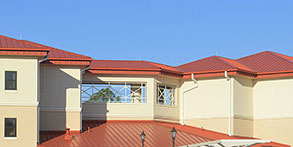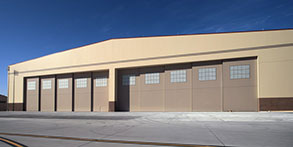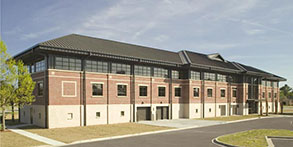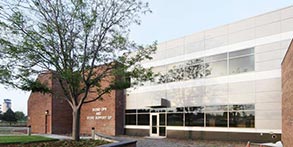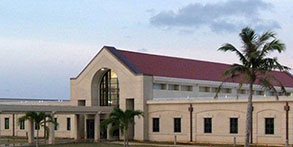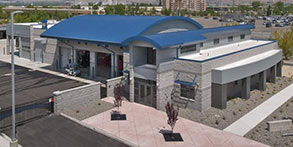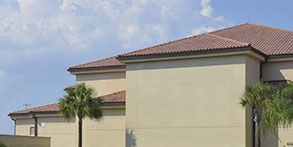- Use proven, cost-effective roof systems with high durability, weather resistance, and low maintenance that are compatible with Installation Facilities Standards (IFS) and requirements for the designated Facility Group.
- Sloped standing seam metal is the preferred standard for Groups 1, 2 and 3 facilities, however large buildings may use low-slope sub-massing components.
- Asphalt or fiberglass shingle is the preferred standard roof for Group 4 buildings.
- Roof eaves will extend beyond the exterior wall for roof drainage and shading. Provide overhangs for shading in response to local climatic conditions, sized and proportioned to the height of the facility and to the window openings being shaded.
- South-facing eaves will coordinate with adjacent wall-mounted shading devices.
- The color, shape and slope of the eave and soffit will be compatible and comply with base standards.
- Keep roofs uncluttered and minimize penetrations.
- Break up massive roofs into coordinated smaller components related to building massing concepts; avoid random, arbitrary changes.
- Large expanses of “flat” (1/2:12) roofs are discouraged. These can be used sparingly in combination with primary roof forms for large facilities.
- Increase the insulation value of existing roofing systems during renovations if supported by life cycle cost and structural analysis.
- Roofs will be maintained for the life of the system and replaced in accordance with UFC 3-110-04 and AFI 32-1051.
Design and construct roof systems to shed water and shade walls and openings. Use their reflectance to reduce heat transfer. Select roof materials that will not show excessive weathering or wear during their typical life span.
Roof color, material and form are prominent features and play a significant role in architectural compatibility. Ensure visible roof systems are comparable in shape, slope, material and color on an installation and follow Installation Facilities Standards (IFS) and requirements for the Facility Group.
Coordinate and integrate roof and wall systems to ensure that individual elements have an uncluttered, organized appearance. Avoid overly complicated solutions and combination of multiple styles, forms and types on a facility.
Sustainability
Roofing systems must contribute to the mitigation of heat island effect and provide a Solar Reflectance Index (SRI) as outlined in these standards. When life cycle cost effective and allowed by law, design roof systems with full integration of rainwater collection, non-potable irrigation and stormwater systems.
Following the directives of UFC 1-200-02, evaluate the life-cycle cost effectiveness of “passive” building components that provide shading, such as roof overhangs and fixed shading grilles, meshes and screens.
Resilience
Provide engineered designs in response to documented risks associated with high winds, hurricanes and typhoons for all roof materials and detailing. Consider the design of overhangs and roof features such as clerestories, dormers and parapets when selecting roof materials and detailing roof systems.
UFC 1-200-01 General Building Requirements https://www.wbdg.org/dod/ufc/ufc-1-200-01
UFC 1-200-02 High Performance and Sustainable Building Requirements https://www.wbdg.org/dod/ufc/ufc-1-200-02
UFC 3-101-01 Architecture https://www.wbdg.org/dod/ufc/ufc-3-101-01
UFC 3-110-03 Roofing https://www.wbdg.org/dod/ufc/ufc-3-110-03
UFC 3-110-04 Roofing Maintenance and Repair https://www.wbdg.org/dod/ufc/ufc-3-110-04
UFC 3-210-10 Low Impact Development https://www.wbdg.org/dod/ufc/ufc-3-210-10
UFC 3-575-01 Lightning and Static Electricity Protection Systems https://www.wbdg.org/dod/ufc/ufc-3-575-01
UFC 4-010-01 DoD Minimum Antiterrorism Standards for Buildings https://www.wbdg.org/dod/ufc/ufc-4-010-01
AFI 32-1051 Roof Systems Management https://static.e-publishing.af.mil/production/1/af_a4/publication/afi32-1051/afi32-1051.pdf
ETL 08-10 Alternative Water Sources – Use of Non-Potable Water https://www.wbdg.org/FFC/AF/AFETL/etl_08_10.pdf

